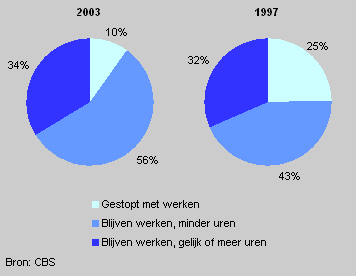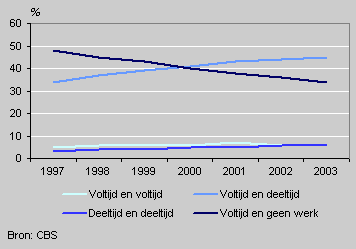Nine out of ten women go back to work after having a baby

More and more women do not consider the birth of a baby as a reason to give up their job. Ninety percent of women who had their first baby in 2003 went back to work after the birth. In 1997 still only three quarters of women went back to work. New mothers do often cut back on the number of hours they work, though. In 2003, 45 percent of couples with children under 18 years of age combined a full-time and a part-time job.
More women going back to work
Many Dutch women have their first baby around the age of thirty. Fewer and fewer of them are giving up their job once they start a family and so more and more are combining work and children. In 2003, eight out of ten young mothers worked before they had their baby. Once they’d had the baby’s 10 percent gave up their job; in 1997 one quarter of mothers did not go back to work after the birth of their first child.
Women and paid work after birth of first child

Most women work fewer hours
Many mothers do cut back on the weekly number of hours they work, however. In 2003, 56 percent of working women who went back to work after having a baby worked for fewer hours than before they had the baby. In 1997 this was 44 percent. One third of women stayed on for the same number of hours, around the same proportion as in 1997. There has therefore been a shift from stopping work altogether to staying on, but for fewer hours a week.
Most new fathers work same number of hours
Young fathers hardly ever alter the number of hours they work when they have children. In 2003, 13 percent of fathers work fewer hours or stop working after the birth of baby. This is only slightly up from 1997, when 10 percent of fathers cut back their hours or gave up their jobs altogether.
Most parents combine full-time and part-time jobs
In families with children under the age of 18, the most popular combination for working parents is a full-time and a part-time job. In 2003, 45 percent of couples with children consisted of one parent (usually the father) who worked full-time, and one who worked part-time. This is ten percent points up on the figure in 1997. In this period the proportion of families with one working parent working full-time fell from 48 to 34 percent.
Labour participation of couples with under-aged children

In 2003, 6 percent of families with young children had two parents working part-time. This combination is increasing slowly: in 1997 only 3 percent of couples both worked part-time.
Ingrid Beckers